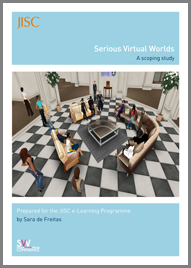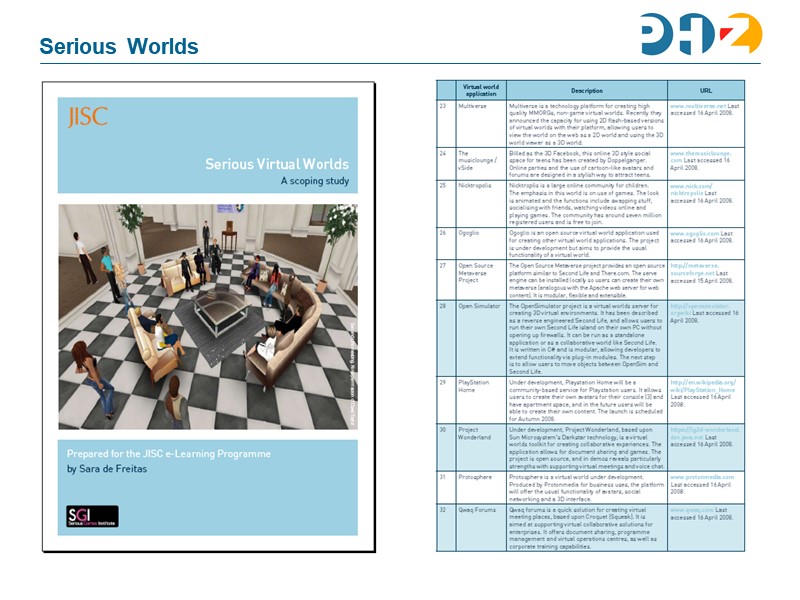Serious Virtual WorldsA scoping study
|

|
 Diese Seite wurde seit 1 Jahr inhaltlich nicht mehr aktualisiert.
Unter Umständen ist sie nicht mehr aktuell.
Diese Seite wurde seit 1 Jahr inhaltlich nicht mehr aktualisiert.
Unter Umständen ist sie nicht mehr aktuell.
 Zusammenfassungen
Zusammenfassungen
 This report provides a scoping study of the use of serious virtual worlds to support learning and training, including a review of the field and case study examples. The report also provides valuable resources such as a typology and a list of virtual worlds.
This report provides a scoping study of the use of serious virtual worlds to support learning and training, including a review of the field and case study examples. The report also provides valuable resources such as a typology and a list of virtual worlds. The Serious Virtual Worlds report focuses on virtual worlds for educational uses, and explores the ‘serious’ - as opposed to leisure-based - uses of virtual worlds.
The Serious Virtual Worlds report focuses on virtual worlds for educational uses, and explores the ‘serious’ - as opposed to leisure-based - uses of virtual worlds.
One of the problems with this area is that there is a plethora of virtual worlds available and practitioners do not always know which one to use and in which contexts. In order to help practitioners to identify the worlds that are the most relevant for their particular learning context, the report presents an overview of the available virtual worlds, describing in particular the serious virtual worlds that have educational potential or have been used in education and training settings. However, stepping beyond this traditional mode of teacher and learner, the report also aims to foreground how learners themselves are becoming a more central component in the use of immersive worlds, creating learning experiences for themselves and adopting a more exploratory mode of learning.
The aim of the report then is two-fold: to provide a context for learning practitioners and policy makers, aiding with their understanding of virtual worlds and how they can be selected and used in tertiary education; and to highlight how learners, through greater empowerment, may play a different and enriched role in the process of forming collaborative learning experiences and engaging in activities which may support their own learning and meta-reflection.
Learning through engagement in immersive worlds has been documented in previous work, as noted. But perhaps counter-intuitively, the emphasis on engagement has evolved from greater empowerment of the learner through learner control (eg over their avatar). While of course this learner control does not automatically lead to exploratory, challenge and problem-based learning experiences, the opportunities for learners to meld and define their learning experiences or pathways, using the virtual mediations within virtual worlds, has the potential to invert the more hierarchical relationships associated with traditional learning, thereby leading to more learner-led approaches based upon activities for example. This implied inversion of the norms of education does of course at its heart offer a direct challenge to our understanding of how we learn. Structure for learning is no longer posited through knowledge acquisition. Instead we have the real capability to offer very practical engagement and social interactions with realistic contexts, to offer conceptual experimentation and to create role plays that facilitate for example different interpretations of historical events and more textured use of information (eg overlay of data and images) to scaffold learning.
 Dieses Buch erwähnt ...
Dieses Buch erwähnt ...
 Dieses Buch erwähnt vermutlich nicht ...
Dieses Buch erwähnt vermutlich nicht ... 
 Nicht erwähnte Begriffe | Eliza |
 Tagcloud
Tagcloud
 Vorträge von Beat mit Bezug
Vorträge von Beat mit Bezug
 Zitationsgraph
Zitationsgraph
 Zitationsgraph (Beta-Test mit vis.js)
Zitationsgraph (Beta-Test mit vis.js)
 1 Erwähnungen
1 Erwähnungen 
- Die Sehnsucht nach dem Büro und dem informellen Austausch - Erfahrungen mit dem digitalen Nachbau des Hochschulcampus während der coronabedingten Fernlehre und Homeofficepflicht (Beat Döbeli Honegger) (2021)


 Volltext dieses Dokuments
Volltext dieses Dokuments
 |  Serious Virtual Worlds: Gesamtes Buch als Volltext ( Serious Virtual Worlds: Gesamtes Buch als Volltext ( : :  , 1380 kByte; , 1380 kByte;  : :  2020-11-28) 2020-11-28) |
 Anderswo suchen
Anderswo suchen 
 Beat und dieses Buch
Beat und dieses Buch
Beat hat dieses Buch während seiner Zeit am Institut für Medien und Schule (IMS) ins Biblionetz aufgenommen. Beat besitzt kein physisches, aber ein digitales Exemplar. Eine digitale Version ist auf dem Internet verfügbar (s.o.). Es gibt bisher nur wenige Objekte im Biblionetz, die dieses Werk zitieren. Beat hat dieses Buch auch schon in Vorträgen erwähnt.










 Chatbot
Chatbot E-Learning
E-Learning Künstliche Intelligenz (KI / AI)
Künstliche Intelligenz (KI / AI) skype
skype VoIP
VoIP






 Biblionetz-History
Biblionetz-History